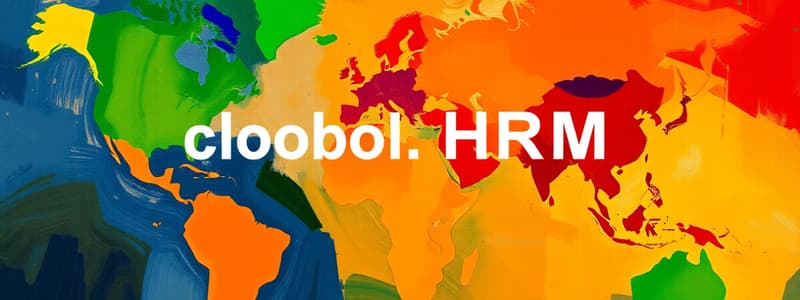Podcast
Questions and Answers
Which of the following aspects of total rewards is most likely to be influenced by local laws and cultural expectations when managing human resources globally?
Which of the following aspects of total rewards is most likely to be influenced by local laws and cultural expectations when managing human resources globally?
- Equity-based compensation programs.
- Sales commission rates.
- Executive bonus structures.
- Health care and retirement benefits. (correct)
When considering workforce planning in a global economy, what is the strategic significance of evaluating the cost and availability of workers?
When considering workforce planning in a global economy, what is the strategic significance of evaluating the cost and availability of workers?
- It primarily affects the timing of employee promotions.
- It solely determines the locations for new facilities.
- It is mainly used for budgeting annual salary increases.
- It informs decisions about the level of global participation and operational locations. (correct)
What is the primary challenge in performance management across national boundaries?
What is the primary challenge in performance management across national boundaries?
- Ensuring consistent application of performance standards across all locations.
- Motivating employees with monetary rewards instead of recognition.
- Adapting methods to align with local culture, legal requirements, and business practices. (correct)
- Implementing advanced technology for performance tracking.
Which of the following best describes the role of culture in determining the effectiveness of HRM practices in a global context?
Which of the following best describes the role of culture in determining the effectiveness of HRM practices in a global context?
How do advances in telecommunications and information technology impact HRM in a global environment?
How do advances in telecommunications and information technology impact HRM in a global environment?
When a company expands its operations from a domestic to a multinational level, what is the most significant change in its HRM requirements?
When a company expands its operations from a domestic to a multinational level, what is the most significant change in its HRM requirements?
What is the main consideration for companies when setting up operations globally?
What is the main consideration for companies when setting up operations globally?
In the context of international assignments, what does 'repatriation' refer to?
In the context of international assignments, what does 'repatriation' refer to?
Why is it important for global organizations to understand the emotional stages of adjustment, including culture shock, for employees on international assignments?
Why is it important for global organizations to understand the emotional stages of adjustment, including culture shock, for employees on international assignments?
How does a 'global organization' differ from a 'multinational company' in its approach to HRM?
How does a 'global organization' differ from a 'multinational company' in its approach to HRM?
What critical factor primarily determines whether companies choose to locate their operations in a specific country?
What critical factor primarily determines whether companies choose to locate their operations in a specific country?
In what way does geopolitical risk most significantly affect global HRM strategies?
In what way does geopolitical risk most significantly affect global HRM strategies?
What is the primary reason for assignment failure in global relocations?
What is the primary reason for assignment failure in global relocations?
In the context of international labor relations, why is relying on host country nationals beneficial for organizations?
In the context of international labor relations, why is relying on host country nationals beneficial for organizations?
How should T+D (Training and Development) programs be designed to effectively cater to a global workforce?
How should T+D (Training and Development) programs be designed to effectively cater to a global workforce?
How do domestic policies (environmental, labor and immigration) in a country impact global business operations and HRM?
How do domestic policies (environmental, labor and immigration) in a country impact global business operations and HRM?
What is the defining characteristic of a 'Home country' in the context of global HRM?
What is the defining characteristic of a 'Home country' in the context of global HRM?
What is the strategic importance of Trade Agreements such as USMCA (United States-Mexico-Canada Agreement) for global businesses?
What is the strategic importance of Trade Agreements such as USMCA (United States-Mexico-Canada Agreement) for global businesses?
What does 'Geopolitical risk' primarily encompass in the context of global business operations?
What does 'Geopolitical risk' primarily encompass in the context of global business operations?
Which consideration is most important when determining the level of participation in a global economy?
Which consideration is most important when determining the level of participation in a global economy?
Which would be an example of a domestic industrial policy that might impact global business?
Which would be an example of a domestic industrial policy that might impact global business?
Which best describes a tool a company can use to prepare expatriates for international assingments?
Which best describes a tool a company can use to prepare expatriates for international assingments?
Which of the following is a trend for international labor relations?
Which of the following is a trend for international labor relations?
What must firms contemplate when they offer packages involving benefits in a foreign nation?
What must firms contemplate when they offer packages involving benefits in a foreign nation?
What is "repatriation"?
What is "repatriation"?
Which of the following countries works the most hours per year in a recent study?
Which of the following countries works the most hours per year in a recent study?
Which of the following is the most important for HRM?
Which of the following is the most important for HRM?
Which of the following countries has CPHR Canada agreements?
Which of the following countries has CPHR Canada agreements?
What is the term for a country that is neither the home country or host country?
What is the term for a country that is neither the home country or host country?
Flashcards
International Business and HRM
International Business and HRM
Growth in international business impacts HRM.
Home Country
Home Country
A country where an organization's headquarters are located.
Host Country
Host Country
A country (other than the home country) in which an organization operates a facility.
Third Country
Third Country
Signup and view all the flashcards
Domestic Organizations
Domestic Organizations
Signup and view all the flashcards
International Organization
International Organization
Signup and view all the flashcards
Multinational Company
Multinational Company
Signup and view all the flashcards
Global Organization
Global Organization
Signup and view all the flashcards
Factors Affecting HRM
Factors Affecting HRM
Signup and view all the flashcards
Workforce Planning Considerations
Workforce Planning Considerations
Signup and view all the flashcards
Criteria for International Success
Criteria for International Success
Signup and view all the flashcards
T+D Global Workforce
T+D Global Workforce
Signup and view all the flashcards
Cross-Cultural Adjustment
Cross-Cultural Adjustment
Signup and view all the flashcards
Global Performance Management
Global Performance Management
Signup and view all the flashcards
Global Compensation
Global Compensation
Signup and view all the flashcards
International Labour Relations
International Labour Relations
Signup and view all the flashcards
Repatriation
Repatriation
Signup and view all the flashcards
Study Notes
Managing Human Resources Globally
- Growth in international business significantly affects HRM practices
- Key factors influence HRM in global markets
- International operations affect various HR practices: workforce planning, selection, training, performance management, total rewards, and labor relations
- Employers should effectively manage and prepare employees for international assignments, including repatriation
Tim Hortons' Global Expansion
- Tim Hortons operates in 20 global markets
- The first store in India opened in 2022, with plans for over 300 stores by 2032
- Two stores in India opened on the same day in January 2025
- In China, the first store opened in 2019, with 1,000 locations by 2024
- Menus are adapted to local tastes, such as salted egg yolk TimBits in China
HRM and the Global Environment
- Globalization creates new markets with millions of new customers
- Setting up operations globally requires balancing risks and rewards
- Geopolitical risks, like wars, trade wars, and political polarization, must be considered
- Advances in telecommunications and IT enable companies to distribute work globally
Geopolitical Shifts
- Create both barriers and opportunities for businesses
- Trade agreements (free, preferential) impact international activities
- Domestic environmental, labor, and immigration policies play a role
- Tariffs and other trade barriers, such as U.S. tariffs on China's EVs, affect global operations
- Conflicts, like Russia's invasion of Ukraine, create instability
- Technology, intellectual property, and cybersecurity regulations also have an effect
Exiting Global Markets
- McDonald's shuttered all 850 locations in Russia in March 2022 due to the invasion of Ukraine
- This was the first time McDonald's "de-arched" and exited a major market
- This exit cost an estimated $1.4 billion
- The locations were sold to a Siberian franchisee, who agreed to rebrand and retain all 62,000 employees
Global Trade Agreements
- Global activities are encouraged by trade agreements
- The United States-Mexico-Canada Agreement (USMCA) lasts until 2026
- Canada and 10 Asia-Pacific countries have the Comprehensive and Progressive Agreement for Trans-Pacific Partnership (CPTPP)
- HR professionals can get international qualifications
- CPHR Canada has agreements with organizations like the Australian HR Institute and the Bangladesh Society for HRM
International Workforce
- Home country: The country where an organization's headquarters are located
- Host country: A country other than the home country where an organization operates a facility
- Third country: A country that is neither the home country nor the host country of an employer
- Canada is the home country of Fairmont Hotels because its headquarters are in Toronto
- A Fairmont employee who is a Canadian citizen is a home country national
- An American chef working in Barbados is a third country national
- A Barbadian manager working at Fairmont in Barbados is a host country national
Levels of Global Participation
- Progression from domestic to global
- Involves establishing foreign subsidiaries as participation increases
Global Marketplace Employers
- Domestic organizations have a workforce that may consist of new immigrants
- International organizations have facilities in one or more other countries
- Multinational companies build facilities in different countries
- Global organizations use cultural differences as an advantage
- They also need a transnational HRM system
Factors Affecting HRM
- Culture: Influences values and effectiveness of HRM practices
- Education & skill levels: Affect labor markets and company location decisions
- Economic system: Capitalist vs. socialist systems and government involvement impact HRM
- Political-legal system: Laws dictate HRM requirements and reflect cultural values and norms
Global Workforce Planning
- Decisions involve level of participation in a global economy
- Decisions about where and how many employees are needed
- Cost and availability of workers must be considered
- Outsourcing is another element
- Flexibility to reduce workforce is necesssary
Responding to Tariffs
- Taiwan Semiconductor Manufacturing Company (TSMC) is investing an additional $100B to build 5 microchip fabrication facilities in Arizona
- The goal is to secure market share free from tariffs
- These facilities are expected to be operational in 2028
- They will supply chips to Apple and Nvidia
International Assignments
- Competency in area of expertise
- Ability to communicate
- Flexibility and tolerance of ambiguity
- Sensitivity to cultural differences
- Motivation to succeed
- Enjoyment of challenges
- Willingness to learn
Developing a Global Workforce
- Special challenges require effective training for all participants
- Employees need training to handle culture gaps and other on-the-ground challenges
- Training programs benefit from specific techniques to navigate cultural issues
- Differences among participants
- International labor relations happen in a legal, social and economic context
Cross-Cultural Preparation
- Involves emotional stages of adjustment, including culture shock
Performance Management
- Specific methods require consideration of legal requirements, local business practices, and national culture
- Which behaviors are rated
- How performance is measured
- Who performs the rating
- Type and how feedback is provided (positive vs. negative)
Compensation
- Pay structure
- Market pay structures may differ across countries, reflecting pay level and relative worth of jobs
- Incentive pay
- Incentives are needed for employees, especially those in higher risk areas
- Benefits & services
- All compensation plans must take into account laws, employee expectations, and values
- Work with unions in more than one country
- Day-to-day decisions about labor relations are usually handled by each global subsidiary
Global Relocation
- Top 2 reasons for assignment failure:
- Changing business conditions
- Inability of family to adjust
- Trailing partner career transition services
- Cross-cultural training
- Career development activities
- International assignment letter
Repatriation
- Process of preparing expats to return home after global assigment
- Provide opportunities to use global experience and communication
- Provide validation by providing recognition
Studying That Suits You
Use AI to generate personalized quizzes and flashcards to suit your learning preferences.




